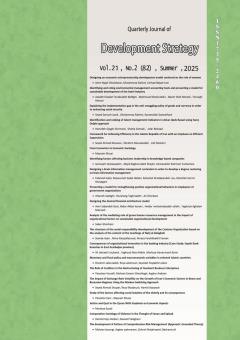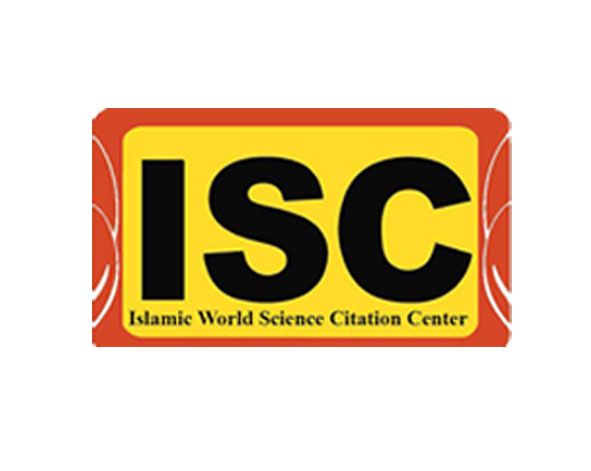About the journal
Recent Articles
-
Open Access Article
1 - Designing an economic entrepreneurship development model centered on the role of women
Amin Najaf Goli Dost ، Gholamreza Rahimi * ، Farhad Nejad iraniIssue 82 , Vol. 21 , Summer 2025 -
Open Access Article
2 - Identifying and rating environmental management accounting tools and presenting a model for sustainable development of the hotel industry
Azadeh Elsadat Torabzadeh Bafeghi ، Mahmoud Moinuddin * ، nasim Shah Moradi ، Forough heiraniIssue 82 , Vol. 21 , Summer 2025 -
Open Access Article
3 - Explaining the implementation gap in the anti-smuggling policy of goods and currency in order to enhancing social security
SEYEED dariush javid ، Gholamreza Rahimi * ، Karamolah DaneshfardIssue 82 , Vol. 21 , Summer 2025 -
Open Access Article
4 - Identification and ranking of talent management indicators in Astan Qods Razavi using fuzzy Delphi approach
hamideh ojaghi shirmard ، Shahla Sohrabi * ، jafar beikzadIssue 82 , Vol. 21 , Summer 2025 -
Open Access Article
5 - Framework for Achieving Efficiency in the Islamic Republic of Iran with an Emphasis on Efficient Supervision
Seyed Ahmad Mosavi * ، Ebrahim Mousazadeh ، Vali RostamiIssue 82 , Vol. 21 , Summer 2025 -
Open Access Article
6 - From Economics to Economic Sociology
Maysam MusaiIssue 82 , Vol. 21 , Summer 2025 -
Open Access Article
7 - Identifying factors affecting business leadership in knowledge-based companies
somayieh sarbazghadim ، majid bagerzadeh * ، Kamaleddin RahmaniIssue 82 , Vol. 21 , Summer 2025 -
Open Access Article
8 - Designing a brain information management curriculum in order to develop a degree centering on brain information management
Fatemeh Sati ، massomehalsadat abtahi * ، Ruhollah Khoda bandelou ، Roohalla KarimikhoyganiIssue 82 , Vol. 21 , Summer 2025 -
Open Access Article
9 - Presenting a model for strengthening positive organizational behaviors in employees of government organizations
afsaneh sadeghi ، Houshang Taghizadeh * ، ali ghorbaniIssue 82 , Vol. 21 , Summer 2025 -
Open Access Article
10 - Designing the desired financial architecture model
Amir Tabandeh Dost ، Akbar Kanani * ، Heidar mohamadzadeh salteh ، Yaghob AghdamIssue 82 , Vol. 21 , Summer 2025 -
Open Access Article
11 - Analysis of the mediating role of green human resources management in the impact of organizational factors on sustainable organizational development
saber ghorbani *Issue 82 , Vol. 21 , Summer 2025 -
Open Access Article
12 - The structure of the social responsibility development of the Customs Organization based on the analysis of the content of the teachings of Nahj al-Balagheh
siamk Azari ، Nima Ranji jafroudi * ، Alireza Farokhbakht Foomani ، Alireza Farokhbakht FoomaniIssue 82 , Vol. 21 , Summer 2025 -
Open Access Article
13 - Consequences of organizational innovation in the banking industry (Case Study: Sepeh Bank branches in East Azarbaijan province)
Ali Jibraeli Joband ، Yaqhoub Alavi Matin * ، Mortaza Honarmand AzimiIssue 82 , Vol. 21 , Summer 2025 -
Open Access Article
14 - Monetary and fiscal policy and macroeconomic variables in selected Islamic countries
Ebrahim safarzadeh ، Roya aleemran * ، seyyed ali paytakhti oskooeIssue 82 , Vol. 21 , Summer 2025 -
Open Access Article
15 - The Role of Creditors in the Restructuring of Insolvent Business Enterprises
Parasto yusefi ، Mohsen Emami Gheshlagh * ، asghar arabianIssue 82 , Vol. 21 , Summer 2025 -
Open Access Article
16 - The Impact of Exchange Rate Volatility on the Growth of Iran's Economic Sectors in Boom and Recession Regimes Using the Markov-Switching Approach
Syed Ahmad shojaee ، Reza Maaboudi * ، hamid asayeshIssue 82 , Vol. 21 , Summer 2025 -
Open Access Article
17 - Study of the factors affecting social isolation of the elderly and its consequences
Parastoo Kani * ، Maysam MusaiIssue 82 , Vol. 21 , Summer 2025 -
Open Access Article
18 - Justice and Qest in the Quran With Emphasis on Economic Aspects
Morteza Ezzati *Issue 82 , Vol. 21 , Summer 2025 -
Open Access Article
19 - Comparative Sociology of Violence in the Thought of Fanon and Spivak
Hamed Hajiheidari * ، David TaleqaniIssue 82 , Vol. 21 , Summer 2025 -
Open Access Article
20 - The development A Pattern of Comprehensive Risk Management (Approach: Grounded Theory)
mohsen bozorgi ، asghar pakmaram * ، Zohreh Khajeh Saeid ، ali besharatIssue 82 , Vol. 21 , Summer 2025 -
Open Access Article
21 - English abstracts of articles
Issue 82 , Vol. 21 , Summer 2025
Most Viewed Articles
-
Open Access Article
1 - Analyzing the Strategies for Business Growth and Development in the Field of Industries and Mines (Case Study: South Khorasan Province)
سید علی بنیهاشمی * ، جواد یوسفیIssue 52 , Vol. 13 , Winter 2018 -
Open Access Article
2 - The Formation of Rentier State and its Impact on the Collapse of the Second Pahlavi Regime
مجيد عباسزاده مرزبالي *Issue 52 , Vol. 13 , Winter 2018 -
Open Access Article
3 - Estimation of Risk and Uncertainty in the Iran’s Labor Market
دليري daler *Issue 52 , Vol. 13 , Winter 2018 -
Open Access Article
4 - Knowledge Based City As an Interdisciplinary Concept
مريم جعفري مهرآبادي * ، مريم سجوديIssue 52 , Vol. 13 , Winter 2018 -
Open Access Article
5 - The Impact of Social Collaboration on Economic Growth
Parvaneh Salatin * ، ملورين دانشپناه ، سمانه محمديIssue 52 , Vol. 13 , Winter 2018 -
Open Access Article
6 - The Sociological Study of the Implications of Cultural the Apartments Life in Iran (Stressing Tehran)
علي قلي جوکار * ، مجيد کاشاني ، حسين فکرآزادIssue 52 , Vol. 13 , Winter 2018 -
Open Access Article
7 - Determining factors affecting human recourses recruitment in order to increase productivity in Iran Public agencies
رها نوری نائینی ، Gholamreza Memarzadeh * ، Mahmood AlborziIssue 71 , Vol. 18 , Winter 2023 -
Open Access Article
8 - The Political Economy of Investment in Non-Productive Sectors of Iran
دکتر سیداحسان خاندوزی * ، محسن فتح اله بياتي ، زهرا فاضل فردIssue 52 , Vol. 13 , Winter 2018 -
Open Access Article
9 - Revisiting Social Discount Rate and its Calculating & Applying Approaches
َAmir Hossein Mozayani *Issue 52 , Vol. 13 , Winter 2018 -
Open Access Article
10 - Organizational Entrepreneurship and its Role in Resistance Economy Using Factorial Analysis and Structural Equations
ابوالفضل روحاني * ، عباس کرامتي ، امير مهديآباديIssue 52 , Vol. 13 , Winter 2018





